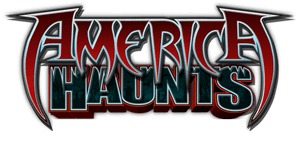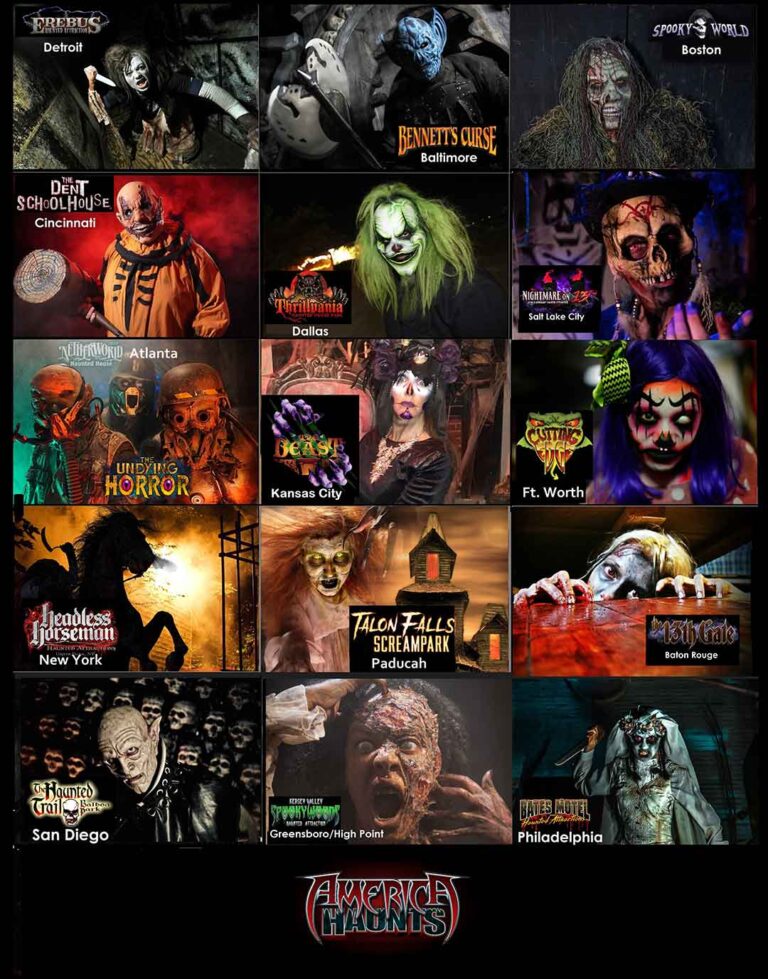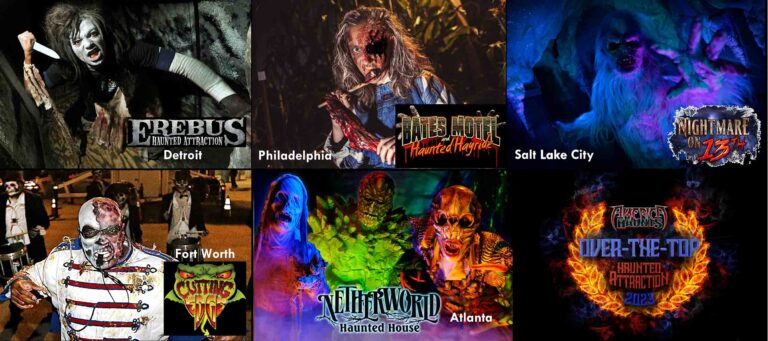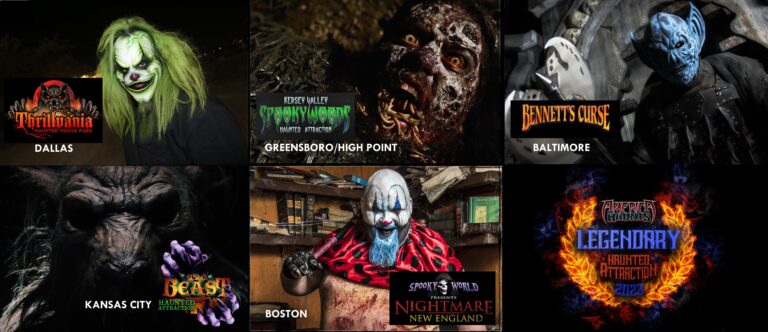The History of Haunted Houses
By: BEKAH McKENDRY
Currently, in the United States alone, there are over 1,200 professional haunted houses, 300 theme parks that operate horror-themed events and over 3,000 charity-run spookshows. But our love of being scared is by no means a recent phenomenon. Haunted attractions have a long history that dates all the way back to our earliest civilizations.
The Ancients
The Egyptians knew well that if you wanted to keep body snatchers away from a pyramid, the best way was to scare the hell out of them. Mazes, moving walls, self-opening doors, traps and the use of snakes and insects were commonplace in preserving treasures and dead royalty. Granted, they weren’t exactly charging admission for these scares, and the public was not lining up to get lost in the snake room, but this is one of the earliest examples of people crafting devices and sets to provoke fear.
The Greeks and Romans also unknowingly seeded the path for haunted attractions. Their folklore is rich with mazes and labyrinths, all filled with monsters. As theater was a vital part of their culture, it stands to reason that these ancients began devising rudimentary special FX to represent monsters and beasts. They also pioneered a number of theatrical devices that would evolve into the spooky elements used in haunts today, including fog, trapdoors, ghostly images and even fake blood and gore. (Fun fact: The ancient Greeks created multiple large-scale special FX contraptions, including the deus ex machina, used to make actors fly, and the ekkyklema, a platform mostly used to reveal dead bodies so the audience could see them.)
The Dark Ages
It’s hard to believe, but this period saw the Christians forwarding the evolution of the haunted house. During this time (around the 1300s through the 1500s), Europe had recently been converted from Celtic and pagan religions to the practice of Christianity, and pageant wagons toured the land performing plays. These were mostly Biblical stories acted out, often including the scarier parts. Though they were intended to frighten folks into staying pious, the attendees enjoyed the scares and gore right along with the morals.
Additionally, this era began the evolution of Halloween as we know it today. Though the holiday was born out of the Celtic and pagan religions, the European masses carried its practices with them as they converted to Christianity. Carving pumpkins, bobbing for apples, dressing up in costume and even trick -or-treating were all pagan practices that were carried over. (Fun fact: Originally, people carved turnips to represent sprits and demons on Halloween. It was believed that hanging these carvings outside would protect your home for the night. When the European settlers came to America, they found very few turnips, but discovered that pumpkins grew in abundance and were much easier to carve. Thus, the jack o’ lantern was born.)
The Renaissance
Society’s love of horror and the development of special FX continued to grow as theater became increasingly popular. Ghosts, demons, the devil and other monsters made regular appearances in plays, including those of William Shakespeare. (Fun fact: In order to create onstage gore during stabbing scenes, actors used to strap pig’s bladders to their midsections. The opposing actor would stab the bladder and pig blood would pour out, making it look as if the actor was actually bleeding to death.)
The 1800s
People became enthralled with ghosts and the possibility of other realms during this century. Mediums, fortune tellers, spiritualists and conjuring sessions to communicate with the dead became a form of entertainment for the elite, and many clairvoyants became renowned celebrities who were paid top dollar for their services. Magician Harry Houdini set out to disprove the practice, and debunked several famous spiritualists.
The haunt-theme path in the theater continued, including John Pepper’s invention of a setup that, through the use of mirrors, made people appear to be translucent apparitions on stage; this device became known as Pepper’s Ghost. The 1800s also saw the opening of the first wax museum, paving the way for future walk-through attractions that played with the patron’s sense of reality. (Fun fact: That same 1800s obsession with death led Mary Shelley to write Frankenstein. First published in 1818, the book sees Frankenstein’s monster brought to life through the real-life practice of galvanism—reanimating the dead with electric shocks.)
The Early 1900s
The beginning of the 20th century saw the height of the traveling carnival, and with it the rise of the freakshow. Patrons would walk through these attractions looking at human deformities and other oddities (many of them fake). Dark rides also became popular amusement attractions; these had patrons sitting on a boat or train and automatically moved through numerous scenes (the best-known variation is probably the Tunnel of Love). As amusement parks and family fun centers sprang up all over the nation, many could not afford a big rollercoaster, so some offered cheap fun-houses and haunted houses to pull in patrons. These were often very dark mazes filled with mirrors and loud buzzers.
Around this time, many of the residential houses built during the early 1800s were becoming worn down and dilapidated. To prevent children from exploring these dangerous buildings, adults would say that ghosts inhabited the neglected homes, further fueling the mystique of haunted dwellings.
The first recorded haunted attraction was the Orton and Spooner Ghost House, which opened in 1915 in the United Kingdom as part of an Edwardian fair. At this time, the Grand Guignol in France was scaring audiences nightly with its graphically staged horror entertainment. (Fun fact: The fake blood of the Grand Guignol was made of soap and bugs! It consisted of equal parts glycerin—clear soap—and carmine, a bright red pigment made by boiling and crushing certain beetles.)
The 1960s
1969 saw the opening of Disneyland’s Haunted Mansion, featuring a spectral sea captain, a ghostly wedding party, transforming portraits and a headless horseman. Walt Disney did not like the idea of putting an old, decrepit-looking structure in the middle of his park, so he took inspiration from San Jose’s Winchester Mystery House and created a lavish mansion with a pristine exterior. Originally, customers were supposed to walk through the Haunted Mansion, but the park staff had problems maintaining their pace and keeping the line moving steadily, so it became a dark ride in which patrons sat in trains (known as “doom buggies”) that carried them through the haunt. (Fun fact: A haunted house was part of Disney’s plan for the park long before Disneyland was built in 1955. In the original pre-construction artists’ renderings, a rundown mansion and graveyard can be seen overlooking Main Street.)
The 1970s
Many haunt owners and even older generations remember having their first spooky-attraction experience courtesy of the Jaycees charity. Short for the United States Junior Chamber, the Jaycees encouraged its young members to put up haunted houses in abandoned buildings or fields as a way to raise money, and the organization became so well-known for these haunts that in 1975, two men from the Bloomington, Illinois chapter, Jim Gould and Tom Hilligoss, decided to write a book about how to create one, detailing makeup FX, scene ideas and marketing strategies . Over 20,000 copies were printed, and Gould and Hilligoss became the first-ever haunted-house experts. They would go on to form The Haunted House Company, one of the first outfits to sell FX, masks, lighting, costumes and marketing materials all in one place . (Fun fact: The two men also created the first-ever Santa’s Village attraction for Christmas.)
The 1980s
As horror movies grew in popularity during this decade, so did haunted houses; most amusement parks boasted a scary attraction of some sort. In 1984, the Haunted Castle at Six Flags Great Adventure in New Jersey caught fire, trapping and killing eight patrons. This set off alarm bells across the industry about the importance of safety, choice of building materials and emergency awareness. Haunts were reshaped to preserve the artificial scares but maintain a high level of safety, ensuring that a tragedy like this would never happen again.
The 1990s – Present
Haunts are everywhere, and not just limited to houses; there are haunted hayrides, mazes and scavenger hunts. Most of us have been through multiple attractions, and for many people, this was their first taste of horror. They’ve become so popular that Halloween enthusiasts known as “home haunters” create attractions at home simply for the love of doing it. Haunts are here to stay, and their industry will only continue to evolve and grow into more terrifying directions. Happy haunting!




